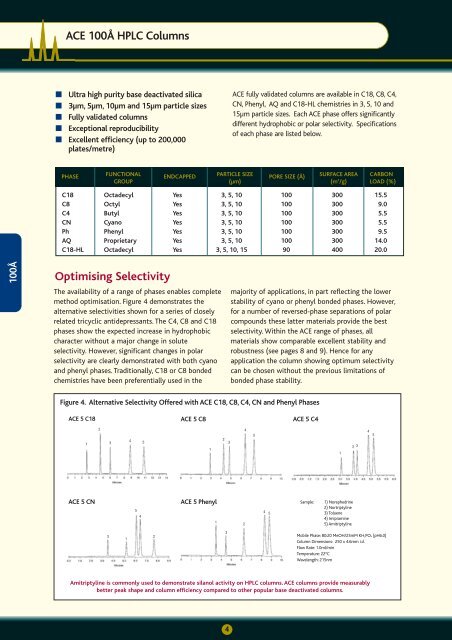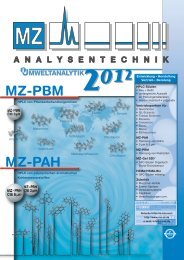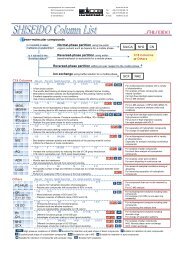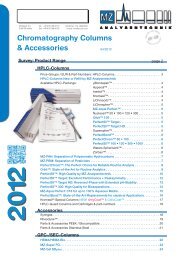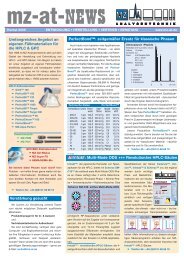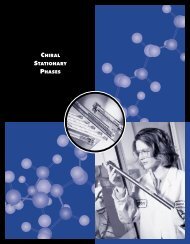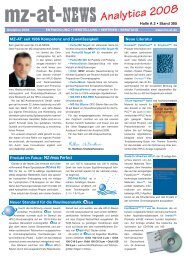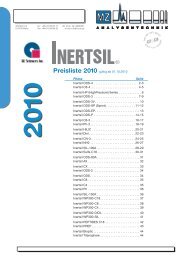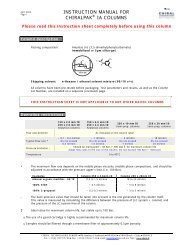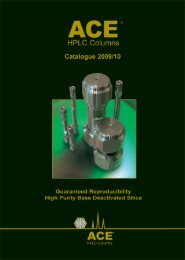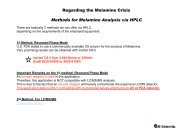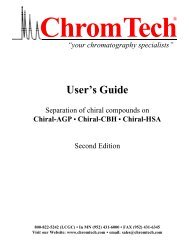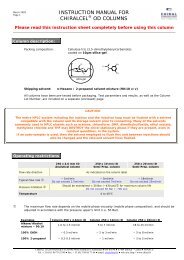You also want an ePaper? Increase the reach of your titles
YUMPU automatically turns print PDFs into web optimized ePapers that Google loves.
100Å<br />
<strong>ACE</strong> 100Å HPLC Columns<br />
■ Ultra high purity base deactivated silica<br />
■ 3µm, 5µm, 10µm and 15µm particle sizes<br />
■ Fully validated columns<br />
■ Exceptional reproducibility<br />
■ Excellent efficiency (up to 200,000<br />
plates/metre)<br />
PHASE FUNCTIONAL ENDCAPPED PARTICLE SIZE PORE SIZE (Å)<br />
GROUP<br />
(µm)<br />
<strong>ACE</strong> fully validated columns are available in C18, C8, C4,<br />
CN, Phenyl, AQ and C18-HL chemistries in 3, 5, 10 and<br />
15µm particle sizes. Each <strong>ACE</strong> phase offers significantly<br />
different hydrophobic or polar selectivity. Specifications<br />
of each phase are listed below.<br />
SURF<strong>ACE</strong> AREA<br />
(m 2 /g)<br />
CARBON<br />
LOAD (%)<br />
C18 Octadecyl Yes 3, 5, 10 100 300 15.5<br />
C8 Octyl Yes 3, 5, 10 100 300 9.0<br />
C4 Butyl Yes 3, 5, 10 100 300 5.5<br />
CN Cyano Yes 3, 5, 10 100 300 5.5<br />
Ph Phenyl Yes 3, 5, 10 100 300 9.5<br />
AQ Proprietary Yes 3, 5, 10 100 300 14.0<br />
C18-HL Octadecyl Yes 3, 5, 10, 15 90 400 20.0<br />
Optimising Selectivity<br />
The availability of a range of phases enables complete<br />
method optimisation. Figure 4 demonstrates the<br />
alternative selectivities shown for a series of closely<br />
related tricyclic antidepressants. The C4, C8 and C18<br />
phases show the expected increase in hydrophobic<br />
character without a major change in solute<br />
selectivity. However, significant changes in polar<br />
selectivity are clearly demonstrated with both cyano<br />
and phenyl phases. Traditionally, C18 or C8 bonded<br />
chemistries have been preferentially used in the<br />
majority of applications, in part reflecting the lower<br />
stability of cyano or phenyl bonded phases. However,<br />
for a number of reversed-phase separations of polar<br />
compounds these latter materials provide the best<br />
selectivity. Within the <strong>ACE</strong> range of phases, all<br />
materials show comparable excellent stability and<br />
robustness (see pages 8 and 9). Hence for any<br />
application the column showing optimum selectivity<br />
can be chosen without the previous limitations of<br />
bonded phase stability.<br />
Figure 4. Alternative Selectivity Offered with <strong>ACE</strong> C18, C8, C4, CN and Phenyl Phases<br />
<strong>ACE</strong> 5 C18 <strong>ACE</strong> 5 C8 <strong>ACE</strong> 5 C4<br />
1<br />
2<br />
3<br />
4<br />
5<br />
1<br />
2<br />
<strong>ACE</strong> 5 CN <strong>ACE</strong> 5 Phenyl Sample: 1) Norephedrine<br />
5<br />
4<br />
1<br />
2<br />
4<br />
5<br />
2) Nortriptyline<br />
3) Toluene<br />
4) Imipramine<br />
5) Amitriptyline<br />
3<br />
1<br />
2<br />
3<br />
Mobile Phase: 80:20 MeOH/25mM KH2PO4 (pH6.0)<br />
Column Dimensions: 250 x 4.6mm i.d.<br />
Flow Rate: 1.0ml/min<br />
Temperature: 22°C<br />
Wavelength: 215nm<br />
Amitriptyline is commonly used to demonstrate silanol activity on HPLC columns. <strong>ACE</strong> columns provide measurably<br />
better peak shape and column efficiency compared to other popular base deactivated columns.<br />
4<br />
3<br />
4<br />
5<br />
1<br />
2 3<br />
4 5


